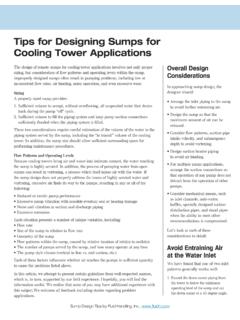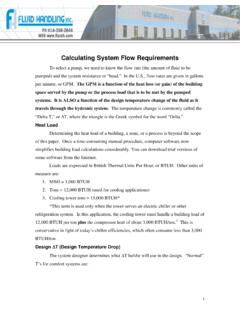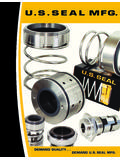Transcription of Selecting the Pump - Fluid H
1 Commercial Hydronics I, Selecting the Pump Selecting the Pump Once the GPM and pump head are known, we can proceed with the actual pump selection. Pumps may be selected either manually using pump curves, or with software such as Taconet. To use software intelligently, however, it is first necessary to understand the manual selection procedure. Generally you will know the pump type that you would like to apply based on the considerations discussed in the pump construction section. At other times, you may not be sure. For example, you may want to use a 1900. in-line pump based on the lower cost vs.
2 A KV vertical in-line. However, you are not sure your conditions can be met with a 1900 pump. In either case a performance field for a given line of pumps provides a starting point. This generalized curve is not a detailed pump curve---it is simply a roadmap to tell you which specific pumps fit your flow and head requirements. The performance field below covers Taco 1900 series pumps. Example 1: 40 GPM at 30 feet. What pump does the performance field recommend? Example 2: 40 GPM at 38 feet. What pump does the performance field recommend? Example 3: 200 GPM at 45 feet. What pump does the performance field recommend?
3 Let's look at example 2, 40 GPM at 38 feet of head. The curve family shows the Figure 1, A Typical Family of Curves 1. Commercial Hydronics I, Selecting the Pump Figure 2, Taco 1919 Pump Curve Let's look at Example 2, 40 GPM at 38 feet of head. The curve family shows the 1919 as a possible selection. At this point we must turn to a detailed curve for that pump, as shown above. Note the series of bold curves sloping downward from left to right. These curves represent the flow vs. head performance of the 1919 pump with different impeller diameters. Specifically, the curve shows performance for diameters of , , , and diameters (see the graph's left side, just inside the hatched area).
4 These are not the only impeller diameters available. Impellers may be trimmed to any diameter between and . The four nominal diameters shown serve only as reference curves to allow interpolation. In addition to the bold flow vs. head performance curves, note the efficiency fields ( u-shaped curves ) and the BHP curves (dashed and sloping from upper left to lower right). BHP means Brake Horsepower in is the actual power used. To evaluate this selection, we 1. Plot the desired flow and head point on the pump curve 2. By interpolation, determine The required impeller diameter BHP. Efficiency 2. Commercial Hydronics I, Selecting the Pump To make the final selection perform the steps above for any curves that you want to consider and choose the best selection.
5 Pump Selection Hints 1. When several pumps will do the job, the most efficient selection is usually the best. 2. Do not extrapolate beyond the largest impeller shown on the curve. The max impeller shown is the largest that fits in the casing! 3. Do not extrapolate beyond the right end of the curve. Pump operation will be erratic, with unstable flows and heads. 4. Do not extrapolate below the minimum impeller size. However, if your selection falls just below the minimum impeller size, you may use that pump by adding false head. This can be accomplished in the field by partially closing a balancing valve thereby artificially increasing the head that the pump sees.
6 5. Try to find a selection close to the best efficiency curve. Selections just to the left of the best efficiency point allow for some runout, and are good selections. However, if your conditions do not favor a high efficiency selection, any point on Taco's published curves will work. Examples 4 and 5. On the curve below, plot the flow vs. head point. Then record impeller diameter, BHP, and efficiency. Also calculate the BHP from the flow, head and efficiency: 4) 40 GPM @ 40' head (water) 5)70 GPM @50' head (water). 3. Commercial Hydronics I, Selecting the Pump Glycol Corrections for Pump Selections Recall that we learned to make corrections to the pressure drop calculation for glycol.
7 Note that this is a piping friction (head) correction. We also learned to calculate the required flow to meet our heat transfer requirements, and found that glycol results in a higher flow rate for a given load and T. This is a system flow correction. Note also that the presence of glycol will affect the performance of a pump. It will reduce the flow, decrease the head capability, and increase the horsepower requirements. The corrections are very small for hot glycol, because the viscosity for hot glycol roughly equals the viscosity of water. However chilled water pump selections, particularly those using cold propylene glycol solutions, require significant performance correction.
8 The table below shows correction factors for various water/glycol mixtures at typical heating and cooling temperatures. To select a pump using this chart, inflate the flow requirements and head requirements by the factors shown before entering the pump curves and enter the curves at the inflated values. Remember that what we are doing is merely overstating the pump requirements to account for the fact that the pump will not perform as well as predicted by the curves for water! Once the pump has been selected using the pump curves, correct the horsepower requirement by the specific gravity (see Table II), then by the viscosity factor.
9 Note that if you are using pump selection software programs, they may already include the specific gravity correction (Taconet does). However, as of this printing, the pump selection software supplied by HVAC pump manufacturers does not include a correction for viscosity. Therefore, correct software-based selections by overstating flow and head at the input screen. Beware of cold start ups! The viscosity correction factor for glycol solutions at typical heating temperatures is However, the heating pump must start with room temperature glycol. Snow melt systems may start with very cold glycol. The biggest consideration is to select a motor that does not overload at the start up condition.
10 In some instances, this may necessitate Selecting a larger motor, depending on the initial selection point. Note that all factors are approximate, but errors should be small, in the range of a few percent. 4. Commercial Hydronics I, Selecting the Pump I. Pump Flow and Head Corrections for Viscosity 30-50% Ethylene and Propylene Glycols Less Than 100 GPM 100 GPM +. Flow Head Flow Head Glycol/ Temp, o-F Correction Correction Correction Correction Ethylene, 40o Ethylene, 190o Propylene, 40o Propylene, 190o II. Pump Power Correction for Specific Gravity 30-50% Ethylene and Propylene Glycols Temp o-F 30% EG 40% EG 50% EG 30% PG 40% PG 50% PG.



![INDEX [www.acmeelectricltd.com]](/cache/preview/c/1/d/c/2/5/3/f/thumb-c1dc253fba0f729e28b29ae16915e7be.jpg)